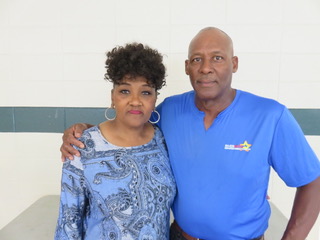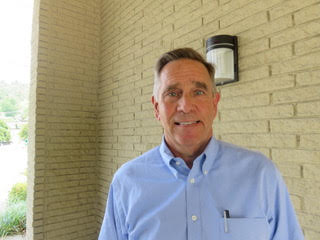
Ed Nelson
photo by John Shearer

James Sears in front of Brainerd
photo by John Shearer

Gail David Elder and Greg Walton
photo by John Shearer

Old lockers still at Brainerd High
photo by John Shearer

Plaque from Brainerd High opening in 1960
photo by John Shearer

Unusual mid-century preformed concrete panels on front of Brainerd High
photo by John Shearer

Yearbook photo shows Rebel flags in stands at 1969 Brainerd-Central game
photo by John Shearer

Seniors in 1969-70 Brainerd yearbook
photo by John Shearer

David Everett
photo by John Shearer
Former Brainerd High School football standout Ed Nelson will never forget the sight he saw on Oct. 11, 1969.
The Rebels under the popular coach Pete Potter were 3-0 and getting ready to play traditional powerhouse Central High under coach E.B. “Red” Etter in a Saturday afternoon game.
Both teams were ranked in the top 10 in the state, with Central at No. 2.
Brainerd at that time had different captains for each game, and Mr. Nelson happened to be the game captain for this big game, which was actually being played at East Ridge due to circumstances that will be explained later.
He recalled going through the pregame warmups and then heading into the locker room for a few minutes.
He did not think the situation among the fans was that much different from other games, but when he came out early for the pregame toss, he looked up in the Brainerd stands and was almost taken aback by what he saw.
“All I can see are Confederate flags,” he recalled vividly during a recent telephone interview from his home in Mississippi.
While the Brainerd players wore Confederate flags on their helmets, and the school band played the fight song, “Dixie,” after every touchdown, this sea of flags was more than support for a football team.
It was support for a way of life for the teenage students and their families connected with the then mostly white Brainerd High. A number of white students at that time would later say it was just about school pride and threatened school heritage and love of the South in general terms, and that many of the white students had only minimal feelings of prejudice toward black people by 1969, if much at all.
That is, despite having grown up seeing many black people often having to live lives as second-class citizens due to the ways of the time, and hearing occasional derogatory jokes toward the black race in white only company.
Meanwhile, the black students of 1969 with memories also dating back to the 1950s knew well of both these more limiting and more prejudiced times, as well as the efforts by Dr. Martin Luther King Jr. and others to bring better opportunities.
To them, the Confederate flag and the playing of “Dixie” represented a place to which they did not want to go or return, as it conjured up images of slavery and other harsh times. As a result, many of the black students began boycotting pep rallies, and then a fight resulted in the Riverside game in early October after some of the black students wanted to damage a Confederate flag.
That set off a week of fear and some chaos leading up to the Central game.
An emotionally painful chapter in Chattanooga’s – and America’s -- seemingly endless road toward racial reconciliation was taking place.
As Mr. Nelson remembered, “To say passions were running high was an understatement.”
According to old articles in the newspapers from that week, on Wednesday, Oct. 8, hundreds of students walked out of school briefly. That night, a number of parents at a Chattanooga Board of Education meeting at Kirkman High downtown demanded that order be restored.
A number of white parents thought their children were being threatened.
From the black perspective, local NAACP leader and Brainerd parent James Mapp said that black and white parents needed to come together as they had at a previous meeting.
Assistant city schools Supt. Dr. C.C. Bond, a pioneering local black educator, had similar comments while speaking at a civic club, saying that the problems were rooted in a lack of communication between blacks and whites.
Later that week, Dr. John P. Hoover, president of the White Citizens Council, paraded through the school grounds with several others before being asked to leave by principal Ray Coleman.
On top of all this unwelcome attention, many white students and parents were parading in cars in the evenings through the Brainerd area with Confederate flags. Some cars were hit by thrown objects.
One initially positive resolution that came during this week in which a curfew had to be put in place in Chattanooga was that a committee of students and others had come up with a list of compromises. They included just making “Dixie” one of a medley of fight songs, and developing a new school flag to replace the Confederate one, while maintaining the Rebels nickname.
The students were to vote on the measure on Monday, Oct. 13, but new schools Supt. Jack Lawrie, with the support of the school board, canceled that plan.
So a tense time continued to ensue that week and in some form for a number of weeks.
Mr. Nelson, a white student, remembers how the situation seemed to change greatly after the fracas at the Riverside game, where fisticuffs ensued, and one black girl reportedly was injured.
“Policemen showed up at Brainerd in the halls -- armed policemen,” he said.
He also recalls the advice he received about staying out of trouble and not putting himself in harm’s way – don’t walk anywhere alone.
“I can’t say I felt scared,” Mr. Nelson recalled almost sarcastically in trying to remember the persona a 17-year-old male was supposed to project. “I was a big tough guy. I had never been scared in my life.”
David Everett, another white student who was a senior that year and played on the tennis team, does recall having a sense of fear and dread over the whole situation.
“There were fights,” he said. “I’d be a liar to tell you I wasn’t” scared.
“There was some heavy yelling, a brick came through a window, and a bus was being rocked,” he continued.
Mr. Nelson added that the whites were collectively afraid of blacks, and he is sure the black people were afraid of white people.
This isolation between the races also exemplified itself in how white people would parade through the black neighborhoods with their Confederate flags, as mentioned, and black guys would drive through the white neighborhoods.
“It was pretty unpleasant stuff,” Mr. Nelson added.
Greg Walton, a junior black student and football player in 1969, remembers that he had friends who were white and he liked his white teachers, but it would usually be the white students he did not know who would be aggravating.
During those tense times that went on for some time, he remembers an incident in which all the black students were forced into the cafeteria in the middle of the school and onto a bus for their safety. But that actually did not keep them from still being targets.
“White kids rocked the bus, and the parents tried to get us out and fight,” he said. “It was chaos. We had parents running around and kids running around.”
Gail David Elder, a black junior who became a cheerleader at Brainerd, remembered that the girls also experienced plenty of tension, even though she felt safer knowing the black male students would try to protect her and others. “You couldn’t ever let them know you were scared,” she said.
Mr. Walton thinks some of the white parents were responsible for many of the problems. “Kids wanted to move on, but the parents wanted to hold on to the Southern heritage,” he said.
James Sears, a black senior that year who admittedly threw some rocks at parading cars of whites with Confederate flags, also remembers some of the white parents being involved.
As an example, he recalls that when a fight broke out at school, everyone came out, and he saw some police officers standing with some white parents. From his perspective, the law officials were supportive of them.
But he also felt a little frustrated at how the situation went among the black students who later started meeting with some respected black adults in the community.
“We wanted to get some guidance from them,” he said, adding that people like Mr. Mapp and the Strickland proprietor of the Franklin-Strickland Funeral Home were involved. “They said don’t provoke but stick together.”
He said the students adhered to this, going to restrooms in groups of two or more. And if they heard about a fight breaking out in school, all the blacks were to leave their classes and go and see if anyone needed help, he added.
Needless to say, it was not an ideal time to be a Brainerd High student, with worries much greater than the typical ones of whom they were going to sit with at lunch, or what they were doing for fun that weekend.
Mr. Sears said the black students and their adult supporters would also try to go to the city Board of Education to express their frustrations, but it would not do any good.
“They would listen to us at the school board meetings, but nothing happened,” he said.
As a result, a kind of frustration would continue to burn on both sides for several initial days, and then continue to simmer for weeks, with different incidents popping back up periodically. It was definitely not an easy time.
While Brainerd High was reflecting the larger world of American society in trying to be made whole through these incidents, the Brainerd football team was already well on the road to perfection.
And as shall be seen in the next installment in this series, the team’s greatest moment came against Central the Saturday after what was probably the school’s most trying time.
* * * * *
To see the previous story in this series, read here:
https://www.chattanoogan.com/2019/8/31/395506/John-Shearer-The-Brainerd-High-Crisis.aspx
* * * * *
jcshearer2@comcast.net